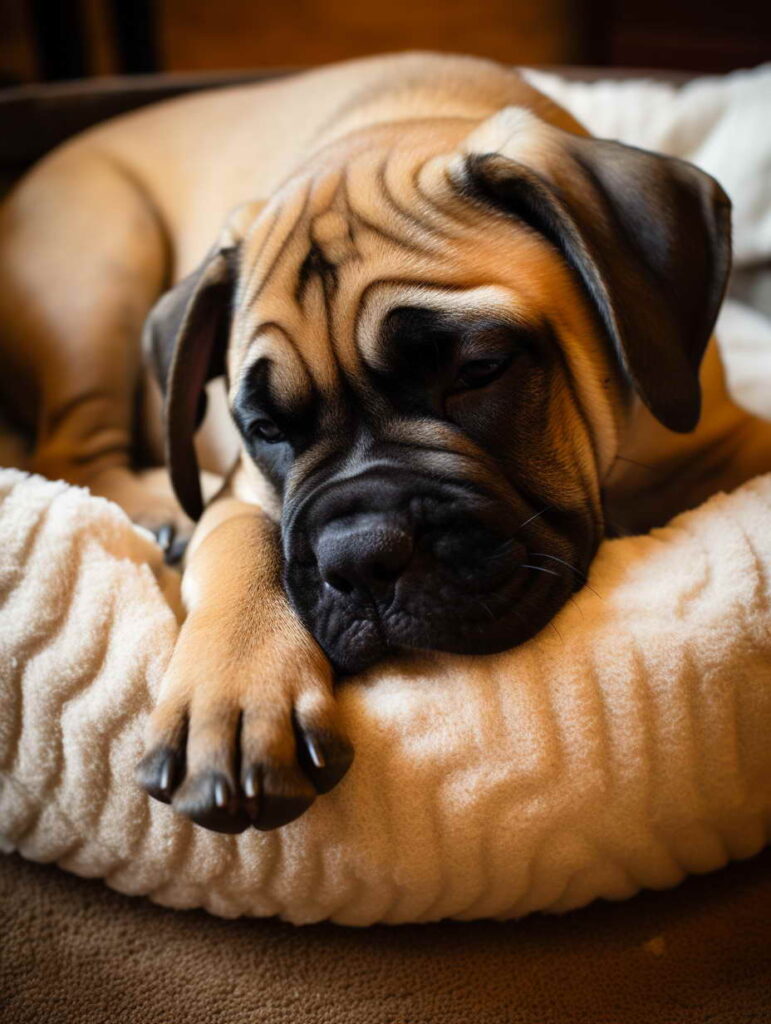
Unleashing the Charm of Bullmastiff Puppy
Introduction
Welcome to the world of Bullmastiff puppies! These adorable furballs are not just pets; they are companions, protectors, and bundles of love. If you’re considering bringing home a Bullmastiff puppy, this comprehensive guide is your roadmap to understanding, training, and caring for these majestic canines. So, let’s embark on this journey to discover the charm of Bullmastiff puppies.
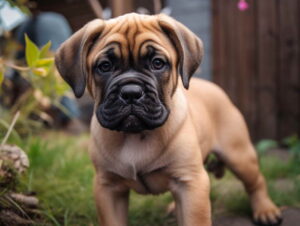
1. Bullmastiff Puppy Basics
Bullmastiff puppies are a unique breed known for their unwavering loyalty and protective nature. In this section, we’ll delve into the fundamental aspects of Bullmastiff puppies.
What Makes Bullmastiff Puppies Special?
Bullmastiff puppies are a breed like no other. Their strong, imposing presence is balanced by a gentle and affectionate demeanor. These dogs are renowned for their protective instincts and make excellent family pets.
Choosing the Perfect Bullmastiff Puppy
Selecting the right Bullmastiff puppy is crucial. Look for reputable breeders who prioritize the health and well-being of their dogs. Bullmastiffs come in various coat colors, so choose one that captures your heart.
The Bullmastiff Puppy Temperament
Understanding your puppy’s temperament is key. Bullmastiff puppies are known for their calm and affectionate nature. They are great with children, making them wonderful family pets.
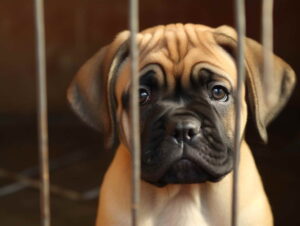
2. Bullmastiff Puppy Breeder
Finding the right Bullmastiff puppy breeder is a crucial step in your journey to welcoming a new furry family member. A responsible breeder can ensure the health, temperament, and overall well-being of your Bullmastiff puppy. Here are some essential factors to consider when selecting a breeder:
Reputation and Accreditation
Start your search by looking for breeders with a solid reputation. Word-of-mouth recommendations from fellow Bullmastiff enthusiasts or referrals from breed clubs can be valuable. Additionally, reputable breeders often belong to recognized kennel clubs and breed associations, which can serve as a mark of credibility.
Health Screening
A responsible breeder prioritizes the health of their dogs. They conduct health screenings for genetic conditions that Bullmastiffs may be prone to, such as hip dysplasia, elbow dysplasia, and certain heart conditions. Ask the breeder for the health clearances of the puppy’s parents.
Ethical Breeding Practices
Ethical breeders adhere to high standards of care and ethics. They provide a clean and safe environment for the puppies, ensuring they are well-socialized. The breeder should also be willing to answer your questions and concerns about the breed and the puppy’s upbringing.
Parental Temperament
The temperament of a Bullmastiff puppy’s parents can be an indicator of what to expect in your new pet. Bullmastiffs should be protective and affectionate. Observing the behavior of the parent dogs can give you insight into the likely disposition of your puppy.
Contracts and Guarantees
A good breeder will provide a written contract that outlines the responsibilities of both the breeder and the buyer. This contract often includes health guarantees, return policies, and other essential details. Be sure to read and understand this document thoroughly.
Home Visit
Visiting the breeder’s home or kennel can provide you with valuable information. You can assess the living conditions of the puppies, meet the parent dogs, and interact with the breeder. This visit can help you ensure that the breeder is genuine and that the puppies are well cared for.
Questions and Communication
Ask the breeder about their experience with Bullmastiffs and how long they have been breeding them. Inquire about the puppy’s diet, vaccination history, and socialization. A transparent and communicative breeder is a positive sign.
References
Don’t hesitate to request references from past buyers of the breeder’s puppies. Speaking to people who have already had the Bullmastiff puppy experience with that breeder can provide valuable insights.
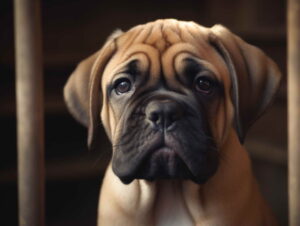
3. Bullmastiff Puppy Rescue
If you’re considering bringing a Bullmastiff puppy into your life, another option to explore is adopting one from a rescue or shelter. Adopting a Bullmastiff puppy through rescue organizations can be a rewarding experience that provides a loving home to a pup in need. Here’s what you need to know about Bullmastiff puppy rescue:
Why Choose Bullmastiff Puppy Rescue
- Saving Lives: By adopting from a rescue organization, you’re giving a Bullmastiff puppy a second chance at a happy life. Many rescue puppies have been abandoned or surrendered due to various reasons, and your adoption can make a significant difference in their lives.
- Supporting Responsible Breeding Practices: Choosing rescue over buying from breeders discourages irresponsible breeding. It promotes ethical treatment of animals by giving homes to those in need instead of perpetuating mass breeding practices.
- Health and Vaccination Records: Most rescue organizations ensure that their puppies are up-to-date on vaccinations and receive proper medical care. This means that your adopted Bullmastiff puppy will likely have a clean bill of health.
- Temperament Assessment: Rescue organizations often assess the temperament of their puppies and provide detailed information about their behavior and needs. This can help you find a Bullmastiff puppy that matches your lifestyle and expectations.
Finding a Bullmastiff Puppy Rescue
- Local Shelters: Start your search for a Bullmastiff puppy at local animal shelters or rescue groups. Many shelters have Bullmastiff mixes and purebreds available for adoption.
- Breed-Specific Rescues: Some rescue organizations specialize in specific breeds, including Bullmastiffs. These groups are knowledgeable about the breed’s unique needs and can be a great resource for finding a Bullmastiff puppy.
- Online Adoption Platforms: Several websites and apps, such as Petfinder and Adopt-a-Pet, allow you to search for Bullmastiff puppies available for adoption in your area. You can filter your search by age, gender, and location.
- Social Media and Networking: Joining Bullmastiff-related forums, groups, and social media communities can connect you with individuals who may be rehoming Bullmastiff puppies. Keep an eye out for adoption posts or discussions in these communities.
The Adoption Process
- Application: When you find a Bullmastiff puppy that captures your heart, you’ll need to complete an adoption application. This is a standard procedure that helps rescue organizations ensure that their puppies are going to loving and responsible homes.
- Home Visit: Some rescue organizations may conduct a home visit or ask for photos of your living space to ensure it’s a safe and suitable environment for a Bullmastiff puppy.
- Adoption Fees: Be prepared to pay an adoption fee, which usually covers the puppy’s vaccinations, spaying/neutering, and other medical expenses. This fee is a fraction of what you would pay for a puppy from a breeder.
- Transition Period: Understand that Bullmastiff puppies from rescue organizations may have had challenging pasts. Be patient and prepared to offer love, support, and guidance as your new puppy adjusts to their forever home.
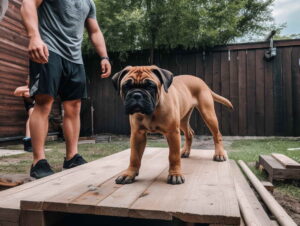
4. Training Your Bullmastiff Puppy
Training a Bullmastiff puppy is a rewarding journey that ensures your pet grows up to be a well-behaved and obedient companion.
House Training
Start with the basics – house training. Establish a routine and use positive reinforcement to teach your puppy where and when to do their business.
Obedience Training
Bullmastiffs are intelligent dogs, but they can be a bit stubborn. Consistent and patient obedience training is essential. Use treats and praise to motivate your puppy.
Socialization
Expose your Bullmastiff puppy to various environments, people, and other animals. This helps them develop good social skills and become confident adults.
Exercise and Play
Bullmastiffs require regular exercise to stay healthy and happy. Daily walks and playtime are essential. Don’t overexert them, though, as they are prone to overheating.
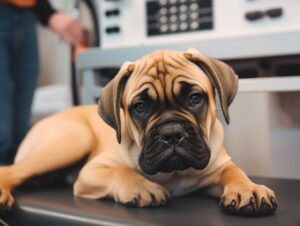
5. Bullmastiff Puppy Health
Ensuring your Bullmastiff puppy’s well-being is of utmost importance. In this section, we’ll cover common health concerns and how to keep your pup in top shape.
Common Health Issues
Bullmastiffs are prone to certain health issues, such as hip dysplasia and bloat. Regular vet check-ups and a balanced diet can help mitigate these risks.
Grooming
Despite their short coat, Bullmastiffs do shed, so regular brushing is necessary. Keep their wrinkles clean to prevent infections. Trim their nails and brush their teeth regularly.
Feeding Your Bullmastiff Puppy
A high-quality, balanced diet is essential for your puppy’s growth. Consult your vet for recommendations and follow a feeding schedule.
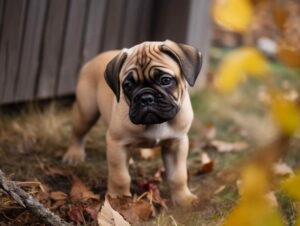
6. How Much Does it Cost to Adopt a Mastiff Puppy?
When it comes to adopting a Mastiff puppy, the cost can vary considerably based on several factors, including the rescue organization, the region you’re in, and the specific services included in the adoption fee. To provide a better understanding, let’s explore the typical price range in USD for adopting a Mastiff puppy:
Adoption Fees
Adoption fees for Mastiff puppies usually range from $200 to $500. These fees are determined by rescue organizations to cover the expenses incurred in preparing the puppy for adoption. Here’s a breakdown of what these fees generally include:
- Spaying or Neutering: Mastiff puppies are typically spayed or neutered before adoption to promote responsible pet ownership. This surgical procedure is usually included in the adoption fee.
- Vaccinations: Puppies require a series of vaccinations to protect them from common diseases. The initial rounds of vaccinations are often covered by the adoption fee.
- Microchipping: Microchipping is a crucial form of identification, and it is typically included in the adoption fee.
- Basic Health Check: To ensure the puppy is in good overall health, rescue organizations provide a basic health check.
- Deworming and Flea Prevention: Most puppies receive treatment for common parasites like worms, and they may be provided with flea prevention.
- Food and Care: The cost of food and general care, which includes feeding and housing the puppies, is often incorporated into the adoption fee.
- Emergency Medical Care: Some rescue organizations offer limited coverage for emergency medical care shortly after adoption in case unforeseen health issues arise.
It’s important to note that while these adoption fees may appear to be a significant upfront cost, they are a fraction of what you would spend on these services if you were to acquire a Mastiff puppy through other means.
Additional Costs
Apart from the adoption fee, there are additional expenses to consider when bringing a Mastiff puppy into your home:
- Supplies: Initial supplies such as a collar, leash, food and water dishes, bedding, and toys can cost between $100 and $200.
- Training and Socialization: Proper training and socialization are crucial for Mastiff puppies. The cost of training classes or private sessions can range from $100 to $500 or more.
- Food: High-quality dog food is essential for your Mastiff’s health. Plan for ongoing food costs, which can range from $50 to $100 per month.
- Grooming: Grooming expenses vary based on your Mastiff’s coat type. Basic grooming may cost around $50 to $75 per session, while more extensive grooming services can cost upwards of $100.
- Vet Care: Although the initial vaccinations and spaying/neutering are usually covered in the adoption fee, ongoing veterinary care, including routine check-ups and vaccinations, should be budgeted for. Regular vet visits may range from $100 to $300 per year.
Budgeting for Your Mastiff Puppy
In total, adopting a Mastiff puppy and providing for their needs can require an initial investment of $500 to $800 or more, depending on various factors. However, it’s crucial to consider the ongoing costs associated with pet ownership, which can add up to several hundred dollars per year. Budgeting for your Mastiff puppy’s needs is essential to ensure they receive the care and attention they require throughout their life.
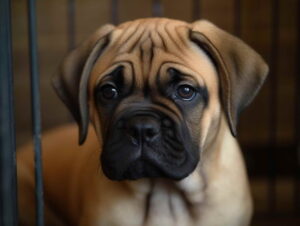
Common Questions About Bullmastiff Puppy
How big do Bullmastiff puppies get?
Bullmastiffs can grow to be around 24 to 27 inches tall and weigh between 100 to 130 pounds.
Are Bullmastiff puppies good with children?
Yes, Bullmastiffs are known for being excellent with children. They are protective and gentle, making them great family pets.
How much exercise do Bullmastiff puppies need?
Bullmastiff puppies need moderate exercise, including daily walks and playtime. Be mindful of their size and avoid overexertion.
Do Bullmastiff puppies drool a lot?
Yes, Bullmastiffs are prone to drooling, so keep a towel handy!
When should I start training my Bullmastiff puppy?
Start training as early as possible to establish good habits and socialization.
How can I find a reputable Bullmastiff breeder?
Look for breeders who prioritize health and ethics. Seek recommendations from Bullmastiff clubs and do thorough research.
Final thoughts
In conclusion, Bullmastiff puppies are a fantastic addition to any family. Their loyalty, protective nature, and loving demeanor make them the perfect companions. Remember, training and proper care are the keys to raising a healthy and happy Bullmastiff. So, go ahead and embrace the joy of having a Bullmastiff puppy in your life!

Leave a Reply